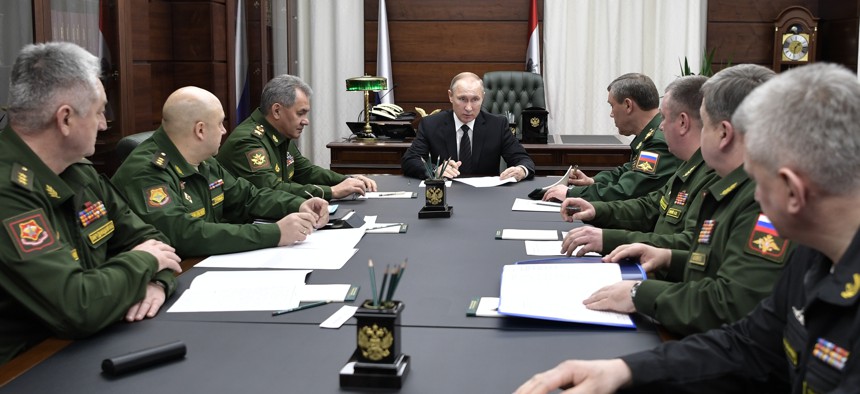
Russian President Vladimir Putin, center, meets with senior military officials in Moscow last year. Alexei Nikolsky/Sputnik via AP
Calm Your Russia War Drums Over This ‘Deconfliction Line’
Yes, the fight is hotter. But we were told this was coming, US and Russian leaders are deconflicting aplenty, and nobody wants war.
Every time the U.S. and Russian militaries, or the forces they support, cross paths in Syria, talk immediately turns to fears of growing tensions or even direct confrontation between superpowers in a war few are following closely. It’s time for a reality check.
Yes, tensions are high on the Syrian battlefield between Assad’s ally Russia and America. Yes, perilous mistakes are possible. But no one didn’t see this coming. And the two sides haven’t stopped talking.
In recent months, the growing story of Russia’s cyber-intervention into the U.S. election has eclipsed stories of Russian cooperation and conversation with U.S. military officials on the ground in Syria. Then something happens – like last week when the U.S. shot down a Syrian fighter jet that dropped bombs close to forces backed by the Americans – and immediately the Pentagon faces questions about whether the “deconfliction line” between the U.S. and Russian militaries is still open and active.
The deconfliction line is important for keeping an uneasy coexistence on the Syrian battlefield, but it is not the sole measure of U.S.-Russian temperatures in the entire Syrian conflict, much less elsewhere. And just because it receives little attention doesn't mean the line keeping the two sides from inadvertently battling one another isn't working, even when rhetoric leads to conclusions to the contrary. After the shoot-down, Moscow said it would shut the line. It didn’t.
“That link is still ongoing here this morning. We’ve still been communicating over the last few hours,” Joint Chiefs Chairman Gen. Joseph Dunford said early last week at the National Press Club, after the Syrian jet was shot down after a series of warnings that went unheeded.
By week’s end U.S. military officials confirmed deconfliction continued, despite Russian words to the contrary. And besides, U.S. military officials have said repeatedly there are other ways the two powers are working to play safe with each other than that line alone.
Related: Defense One's complete coverage of Russia
Related: The United States and Russia Are Increasingly at Odds in Syria
Despite worries that the Trump administration is plunging America into greater war in Syria — and Russian statements that the U.S. downing of the Syrian plane was “helping” ISIS and violating Syria’s sovereignty, the reality is that there is also no shutdown in the Russia-U.S. military-to-military conversation. More importantly, there is no desire on either side to slide, slip or descend into direct confrontation, even if the Assad regime and Iranian-backed militias act in ways aimed at escalating, not stabilizing, tensions between the two nations.
U.S. and Russian leaders are working hard to head-off direct military conflict with one another as they pursue a delicate and uncomfortable coexistence on a small and crowded battlefield. It’s no longer just proxies on the ground, as more and more U.S. regular special operations forces appear alongside – not just behind or above – Syrian fighters. Russia understands U.S. air and overall military superiority, as well as the vulnerability of its naval assets in the region in the event of conflict. It also does not wish to explain to Russian parents why their children died in Syria. On the U.S. side, military officials may have wanted to speed up the fight, but they do not wish to expand it. Nor does the Pentagon wish to waste valuable assets in a delicate war fighting a nuclear power seeking to reestablish itself as a global one.
The complicated reality is that American officials speak frequently with their Russian counterparts. The U.S. is aiming to be clear about the U.S.-backed Kurdish and Arab forces’ intent, and to what extent they are willing to go to defend them if threatened, as the battle for Raqqa heats up.
Under recently received new authorities considered at the end of his term by President Barack Obama and approved by Trump, U.S. forces can now arm the Syrian Kurds in the fight against ISIS. This authority means in reality that the U.S. now can and is prepared to directly provide self-defense for their partner forces — in this case the Syrian Kurds and the Syrian Defense Forces. U.S. military leaders want Russia and the Syrian regime to know that the U.S. can act in defense of those forces, if needed, but would rather not be in that situation in the first place, as the U.S. side’s headquarters in Tampa said following the downing of an Iranian drone.
“The Coalition does not seek to fight Syrian regime, Russian, or pro-regime forces partnered with them, but will not hesitate to defend Coalition or partner forces from any threat,” said U.S. Central Command, in a statement. “The Coalition calls on all parties to focus their efforts on the defeat of ISIS, which is our common enemy and the greatest threat to regional and worldwide peace and security.”
Keeping all sides focused on that common enemy and keeping cooler heads from giving in to hot rhetoric is the challenge ahead for U.S. military leaders as the battlefield gets more crowded and the stakes for Raqqa and its future climb higher.
Indeed, on Friday Russia used the deconfliction line to give the U.S. a heads-up before it launched a cruise missile strike from the Mediterranean at what it said were ISIS targets — including command posts and weapons.
“If we know through the deconfliction line that there are going to be strikes and our forces are not in the area, that’s how we want things to be,” said Col. Ryan Dillon, the U.S. military’s spokesman in Baghdad. “It remains open and we’re not going to discuss every detail.”




